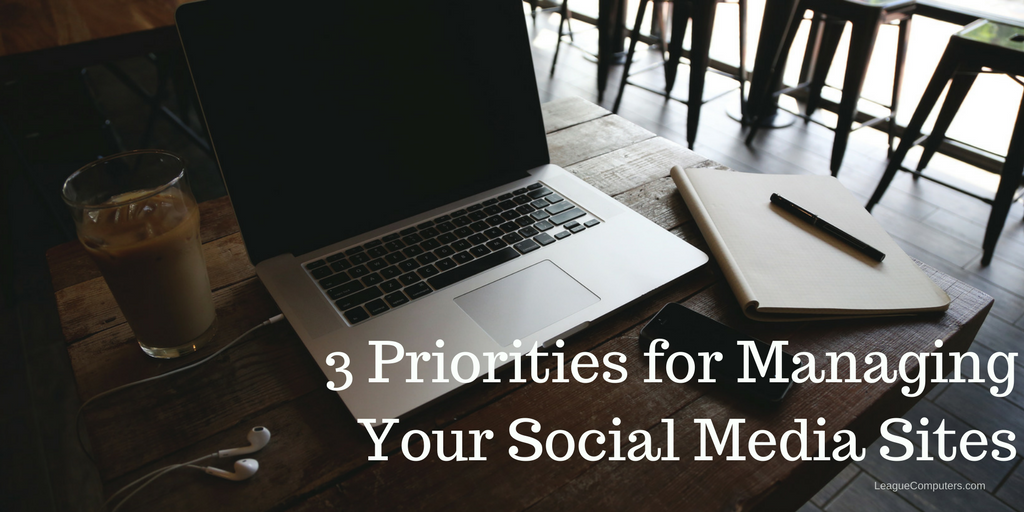
Although this post was published in 2016, these tips are still relevant today. As a small business owner, there are 3 priorities to keep in mind when managing your social media sites: Content, Communication, and Consistency. Focus on these tips as you create specific marketing tasks and campaigns on your sites.
Tip #1: Plan Your Content
You need content for your blog, website, and social media sites. And if you’re currently managing several social accounts, then you already know that coming up with good content on a regular basis is a time-consuming task!
So plan ahead and know what content you’re going to post ahead of time, to avoid wasting hours staring at a blank screen.
Here are a few ideas for the kind of content you should include in your plan:
Your Content:
- Educational, Informational Content (80% of the time), Promotional Content (20% of the time)
- Visuals – photos, videos, live-streaming – it can be as easy as using your smartphone for videos
- A Free piece of content that attracts your target audience and builds your email list – like a free report, white paper, eBook, PDF to download, etc.
- Site-specific content: you may make some content exclusive to a site – like sharing some visuals only with your Instagram followers, or holding a Q & A day on your Facebook page (either through a post and comments, or using LIVE to answer questions through live-streaming)
Other People’s Content Should Be Part of Your Plan:
As a small business owner, it’s highly unlikely that you’ll be able to come up with enough original content to fill up your social sites on a daily basis. Realistically, you’ll need to share content from other people too.
But don’t look at this as a negative: you can become a trusted resource by consistently sharing content that keeps your audience up-to-date on things in your industry.
This is where a Content Curation system comes in. “Curation” in this context refers to finding, sorting, adding your opinion/comments (if applicable), and then sharing other people’s content with your community.
Tip #2: Make Communication a Priority
People expect answers to questions, replies to comments, and good customer service in today’s social media world. So it’s vital to communicate effectively with your community.
You may not have a large staff to answer your followers’ questions, but you need to put a system in place that ensures you respond in a timely manner (we’re talking about legitimate comments/questions on social media; you can block spammers).
Get to know the communication tools available on each of your sites:
- Facebook’s messaging center and settings
- Twitter’s Direct Messages (which are not restricted to the length of a Tweet)
- Instagram’s Direct Messages and “Send” option on posts
- A contact page and/or Form on your website
- Turning on blog comments
You get the idea right? For each site that you’re using, become familiar with its features so you can determine the best way to communicate with your followers there.
You’ll want to monitor your social sites (and the web in general) for mentions of you/your brand. There are a variety of tools available (free and paid) to help you.
Tip #3: Aim for Consistency
As the world of social media becomes more crowded and “noisy”, one way to stand out is by simply showing up on a consistent basis.
Your target audience will most likely be checking out your social media sites well before actually purchasing something from you, so make sure your sites are updated on a routine basis.
Daily updates are ideal, but be realistic about the time and resources available to you. Blogging once or twice a month is fine. Don’t put pressure on yourself to do weekly blog posts if you’re just aiming for quantity over quality. Make it a goal to update your Facebook Page a minimum of 3 times a week if daily updates are not possible.
Set up a system that works with your schedule, do what you can, and then maintain that schedule on a consistent basis.
You may read blog posts and reports on the recommended number of times per day to post on social media. Use those posts as a starting point. Every business is unique, and what works for other businesses may not necessarily be the best for yours.
You will need to be flexible and adapt to trends and changes on social sites…as users’ social habits change. But a consistent, online presence is your long-term goal when managing social media.
Track and measure your efforts and results over a month or a quarter instead of getting caught up in how many times you post per day.
——————
So there you have it: 3 tips to help you focus on top priorities: Content, Communication, and Consistency. Effectively managing your social media is important to your long-term digital marketing success, and these tips should help!
If you have any questions or need some help setting up / optimizing your social media management system, then let me know!
